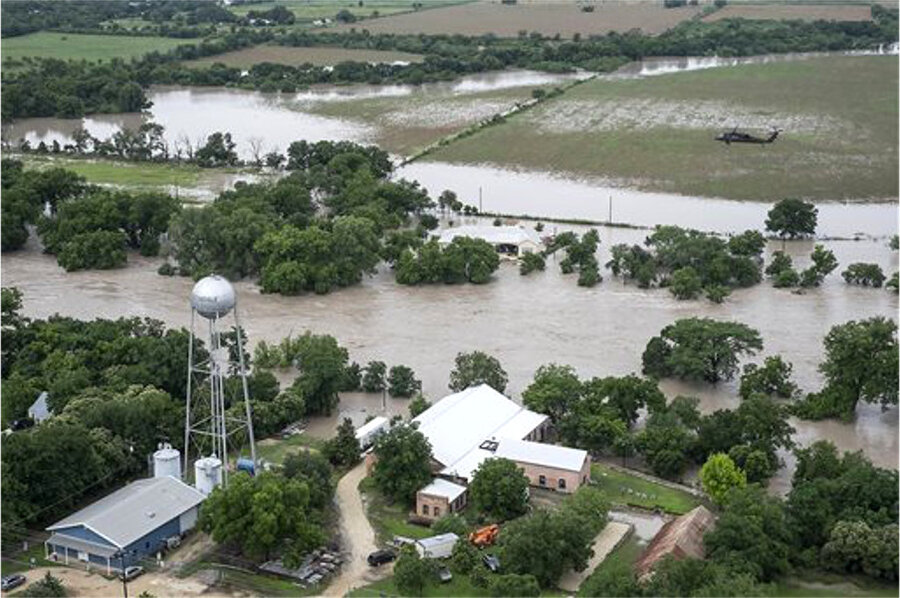Plains torrents loosen drought’s grip: Is this ‘weather whiplash?'
Loading...
| Atlanta
The five-year drought came to a dramatic end in Texas on Sunday, as a straight month of rain built into a torrent that killed at least three people and destroyed more than 1,000 homes, most along the Blanco River that runs roughly between San Antonio and Austin.
Wichita Falls, Texas, where golf courses had long lost their green amid watering restrictions, has become fully saturated in a span of three weeks during the wettest May in the city since 1897. Across the Central Plains, reservoirs that have threatened for years to run dry are, suddenly, full.
The moisture turnaround is a bad-news/good-news scenario involving what some climatologists call “weather whiplash” that may grow more pronounced as nature adjusts to climate change. The theory is that, more so than in the past, persistent weather patterns shift suddenly into new, sometimes opposite, patterns, that then, again, persist.
Despite the Texas deluge, there's evidence that persistent weather also may be calmer weather, at least in certain regions. The US is in a pattern of below-average numbers of tornadoes, with 2012, 2013 and 2014 recording fewer than 1,000 twisters, the lowest numbers since the US began tracking twisters in 1950. One key reason for that trend has been fewer numbers of tornadoes in the drought-stricken Central Plains.
“One of the hallmarks of global warming/climate change appears to be persistent weather – what you see is what you get for a long time,” writes Jon Plotkin for Decoded Science, adding such weather has “been more common in the 21st century.”
“A slow, steady change of climate is relatively easy to deal with [but] lengthy bouts of extreme weather like the flooding in the plains this week: not so easy,” he writes.
Scientists are wary of linking any one specific weather event to climate change, although at this point there is overwhelming consensus in the scientific community – 97 percent of climate scientists, according to NASA – that Earth’s climate is changing.
To that point, the drought-to-flood dynamics in the Plains are not without precedent. A 1950s-era drought that rivaled the one that has recently dogged Texas ended much the same way in 1957: with a steady drum roll of heavy wet weather where, as today, some part of the state received at least one inch of rain every day in May.
And while meteorologists say 2015 will be yet another of Earth’s hottest years, the US as a whole will likely see its coolest summer since 2009, according to the summer energy outlook produced by The Weather Company, a national weather forecasting firm.
Moreover, the heavy rains in Texas and Oklahoma have ties to already existing atmospheric phenomena, specifically a building El Niño. Historically, the warm waters of an El Niño event tend to contribute to higher rainfall in the southern United States.
This is where the potential good news comes into play.
Despite the damage done by the Texas torrents, Californians, who have been enduring a historic drought, now in its fourth year, see glimmers of hope in the potentially drought-busting El Niño, which is the warm phase of an atmospheric oscillation in the tropical Pacific.
"The headlines that you're writing today about Texas and Oklahoma, you could be writing about California in January," Bill Patzert, a climatologist at NASA’s Jet Propulsion Laboratory in La Canada Flintridge, tells the Los Angeles Times. "There's something to remember about El Niño — he's a good boy and he's a bad boy because he can deliver drought relief that's much-needed. But all that water coming so fast is like trying to catch water out of a fire hose with a champagne glass."
That description fits what happened in the Plains Sunday morning, when thousands of residents woke up to streets running like rivers and were forced to flee. In some places, water rose by 26 feet in an hour as already-saturated soils failed to soak up the extra rain.
That rate of rise was historic. The Blanco River shattered a 1929 crest record by six feet, causing “catastrophic" flooding, the National Weather Service said. A total of 21 river gauges in the region were recording “major flood.”
Aside from massive property damage, the human toll was also steep. A firefighter in Oklahoma lost his life during a rescue after he lost his footing and drowned in a drainage ditch. On Monday, 12 people were reported missing in Hay County. Searchers were still looking for eight people, members of two families, in the floods after the vacation home they were staying in was swept away near Wimberley, Texas.
Flash-flood warnings remained in effect from Texas to Tennessee on Monday, as government weathermen predicted yet more rain.








